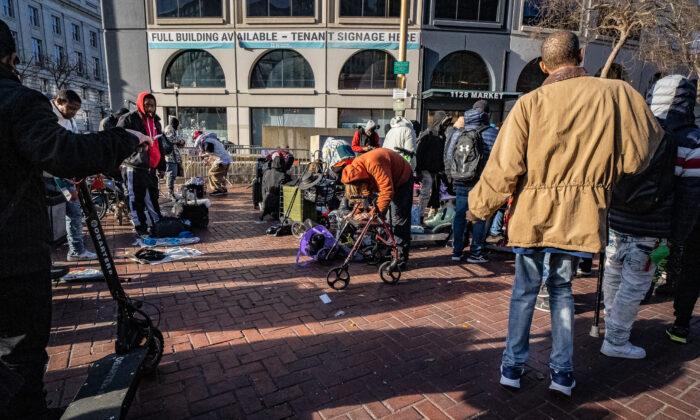ORANGE, Calif.—In the midst of a growing pandemic, Orange County’s homeless outreach programs are struggling to limit a vulnerable target population from the devastating effects of the CCP virus.
Many of the county’s homeless population—particularly those over the age of 60—are not “in tune” with the pandemic, according to Orange County Rescue Mission President Jim Palmer, making efforts to help increasingly difficult.
“Because in many cases, they’re dealing with, like, an addiction on the street, or they’re, you know, more worried about where they’re going to access foods,” Palmer told The Epoch Times.
“And some of the access to food has been cut off, because of the way certain nonprofits or different types of community centers that were distributing food were closed by local cities.”
Palmer said there is currently no threat of the virus in any of their housing placements or emergency shelters, but that will likely change in the coming weeks. In that event, the organization plans to follow the Centers for Disease Control and Prevention’s guidelines for screening patients.
“As we know, those that are 60 or 65 or older are considered to be more vulnerable to the COVID-19 virus, so we’ve spent time looking at our spaces and what we could do to assist them,” Palmer said.
The Orange County Rescue Mission presides over a dozen campuses and programs, and works hand-in-hand with county leaders to provide emergency relief measures to individuals in need.

He added: “And they certainly know who we are, because we’ve been around for 54 years. So they know that we’re a large organization that helps a lot of people. And you know, once they get to the point ‘I really want to get off the street,’ you know where.
Mounting Challenges
Providing basic services like food and shelter has become much more difficult for outreach programs due to the spreading virus, Palmer said. Simply getting in touch with those in need has become a challenge, while food donations have decreased.The rescue mission, along with other emergency nonprofits, finds itself in desperate need of canned foods, water, and paper products.
“But there’s not as many people out [who are able] to buy things, then donate and drop them off,” said Palmer.
He added that simply contacting those in need has become problematic, with in-person surveys becoming more difficult due to COVID-19 restrictions.
“So, primarily, homeless on the street, we hear from them a couple of different ways,” Palmer said. “And the phone is one way.”
Usually, the people who need shelter would call, Palmer said, adding that many California homeless received free, subsidized “Obama phones” that have been used to communicate during outreach, especially regarding food and shelter availability.
Employees are now concentrating on the phone system to contact the homeless. But that too has problems.
“They would email us from, like, the local library,” Palmer said. “Now I realized that at this point libraries are now closing.
“But, in the past, that’s sort of how our communications work, because there is no foolproof way for us to send outreach out in the community.”
Palmer said that “meeting unknown people,” who may be experiencing homelessness for the first time, has become paramount during the crisis.
Homegrown Problem
While those living unsheltered in Orange County are especially vulnerable to the respiratory virus due to sanitary conditions, seniors with underlying medical conditions are at an increased risk of communal spread.“The longer that someone’s on the street, the worse their health gets,” said Atty McLellan, community engagement manager for United to End Homelessness (UEH), at a Feb. 29 seminar held at the Geneva Presbyterian Church in Laguna Woods.
“Which means the longer that someone’s on the street, the likelihood that they might develop that disabling condition becomes more and more likely.”
According to UEH—an outreach program with a mission to end Orange County’s homeless issue by 2024—the county numbered nearly 7,000 homeless in 2019. During the same period, the number of homeless in nearby Los Angeles County measured nearly 59,000.
Many of Orange County’s homeless are over the age of 62, including at least 677 seniors and 311 veterans.
McLellan said that it’s “very concerning that the majority of our seniors that are veterans are not in our shelters, but they’re actually sleeping outside, on our streets, in their cars, things like that.”

UEH’s data also showed that most of Orange County’s homeless population was previously living at a permanent address in the county. Many grew up in California, but fell victim to the region’s soaring rent prices and taxes.
“And that typically goes against what you might hear in the community or what people mostly think of when we think of people who are homeless,” McLellan said. The assumption is often that the county’s homeless came from other regions; they became homeless elsewhere, then migrated to Orange County.
“But 73 percent last lived in Orange County before they became homeless,” McLellan said.
To ramp up efforts to protect the most vulnerable, UEH and their parent organization, The Orange County United Way, created an emergency Pandemic Relief Fund on GoFundMe.
The organization is attempting to raise $500,000, which will support “low-income individuals and families at imminent risk of homelessness; the current OC population experiencing homelessness; low-income students; and our partner non-profits.”
Statewide Efforts
California is home to the largest population of homeless inhabitants in the United States, with approximately 108,000 displaced individuals, according to the governor’s office.“People experiencing homelessness are among the most vulnerable to the spread of COVID-19,” Newsom said in a statement.
“California is deploying massive resources to get these vulnerable residents safely into shelter, removing regulatory barriers and securing trailers and hotels to provide immediate housing options for those most at risk.
“Helping these residents is critical to protecting public health, flattening the curve and slowing the spread of COVID-19.”
San Francisco has considered housing the homeless in shut-down schools and churches in response to COVID-19 concerns, local media have reported.
Homeless advocates have sued officials in Los Angeles for an alleged lack of protection for the homeless. The L.A. Alliance for Human Rights, Mayor Eric Garcetti, and County Supervisor Kathryn Barger were among the parties engaged in a hearing on March 23 presided over by U.S. District Judge David Carter.
Settlement talks have continued as the parties forge a plan to address the problem.





